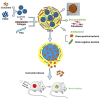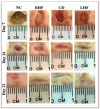Collagen-Based Wound Dressings: Innovations, Mechanisms, and Clinical Applications
- PMID: 40277707
- PMCID: PMC12026876
- DOI: 10.3390/gels11040271
Collagen-Based Wound Dressings: Innovations, Mechanisms, and Clinical Applications
Abstract
Collagen-based wound dressings have developed as an essential component of contemporary wound care, utilizing collagen's inherent properties to promote healing. This review thoroughly analyzes collagen dressing advances, examining different formulations such as hydrogels, films, and foams that enhance wound care. The important processes by which collagen promotes healing (e.g., promoting angiogenesis, encouraging cell proliferation, and offering structural support) are discussed to clarify its function in tissue regeneration. The effectiveness and adaptability of collagen dressings are demonstrated via clinical applications investigated in acute and chronic wounds. Additionally, commercially accessible collagen-based skin healing treatments are discussed, demonstrating their practical use in healthcare settings. Despite the progress, the study discusses the obstacles and restrictions encountered in producing and adopting collagen-based dressings, such as the difficulties of manufacturing and financial concerns. Finally, the current landscape's insights indicate future research possibilities for collagen dressing optimization, bioactive agent integration, and overcoming existing constraints. This analysis highlights the potential of collagen-based innovations to improve wound treatment methods and patient care.
Keywords: angiogenesis; chronic wounds; collagen; collagen wound dressing; crosslinking; polymers; wound healing.
Conflict of interest statement
The authors declare no conflicts of interest.
Figures









Similar articles
-
Advancements in Wound Dressing Materials: Highlighting Recent Progress in Hydrogels, Foams, and Antimicrobial Dressings.Gels. 2025 Feb 7;11(2):123. doi: 10.3390/gels11020123. Gels. 2025. PMID: 39996666 Free PMC article. Review.
-
Conductive hydrogels: intelligent dressings for monitoring and healing chronic wounds.Regen Biomater. 2024 Nov 1;12:rbae127. doi: 10.1093/rb/rbae127. eCollection 2025. Regen Biomater. 2024. PMID: 39776855 Free PMC article. Review.
-
Topical silver for infected wounds.J Athl Train. 2009 Sep-Oct;44(5):531-3. doi: 10.4085/1062-6050-44.5.531. J Athl Train. 2009. PMID: 19771293 Free PMC article.
-
Pullulan-Collagen hydrogel wound dressing promotes dermal remodelling and wound healing compared to commercially available collagen dressings.Wound Repair Regen. 2022 May;30(3):397-408. doi: 10.1111/wrr.13012. Epub 2022 Apr 18. Wound Repair Regen. 2022. PMID: 35384131 Free PMC article.
-
Pullulan-Based Hydrogels in Wound Healing and Skin Tissue Engineering Applications: A Review.Int J Mol Sci. 2023 Mar 4;24(5):4962. doi: 10.3390/ijms24054962. Int J Mol Sci. 2023. PMID: 36902394 Free PMC article. Review.
Cited by
-
Natural Products for Improving Soft Tissue Healing: Mechanisms, Innovations, and Clinical Potential.Pharmaceutics. 2025 Jun 8;17(6):758. doi: 10.3390/pharmaceutics17060758. Pharmaceutics. 2025. PMID: 40574070 Free PMC article. Review.
-
Advancements in Nanotechnology for Spinal Surgery: Innovations in Spinal Fixation Devices for Enhanced Biomechanical Performance and Osteointegration.Nanomaterials (Basel). 2025 Jul 10;15(14):1073. doi: 10.3390/nano15141073. Nanomaterials (Basel). 2025. PMID: 40711192 Free PMC article. Review.
-
Therapies and delivery systems for diabetic wound care: current insights and future directions.Front Pharmacol. 2025 Jul 22;16:1628252. doi: 10.3389/fphar.2025.1628252. eCollection 2025. Front Pharmacol. 2025. PMID: 40766758 Free PMC article. Review.
-
Zinc Alginate Hydrogel-Coated Wound Dressings: Fabrication, Characterization, and Evaluation of Anti-Infective and In Vivo Performance.Gels. 2025 Jun 1;11(6):427. doi: 10.3390/gels11060427. Gels. 2025. PMID: 40558725 Free PMC article.
-
A Recent Insight into Research Pertaining to Collagen-Based Hydrogels as Dressings for Chronic Skin Wounds.Gels. 2025 Jul 8;11(7):527. doi: 10.3390/gels11070527. Gels. 2025. PMID: 40710689 Free PMC article. Review.
References
-
- McGrath J.A., Uitto J. Rook’s Textbook of Dermatology. John Wiley & Sons; Hoboken, NJ, USA: 2024. Structure and Function of the Skin; pp. 1–50.
-
- Mahmoudi M., Gould L.J. Opportunities and Challenges of the Management of Chronic Wounds: A Multidisciplinary Viewpoint. Chronic Wound Care Manag. Res. 2020;7:27–36. doi: 10.2147/CWCMR.S260136. - DOI
Publication types
LinkOut - more resources
Full Text Sources

